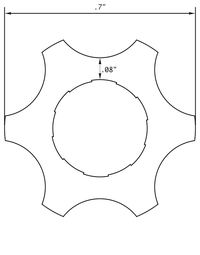I'm building a 9mm carbine, including profiling the barrel.
How thin can I make it and maintain safety?
I don't mean "at the chamber", I mean "at least 2.5 inches from the breech"
I want it to be light, but not at the expense of being sloppy/floppy, so I want to put flutes in it.
How deep can I make the flutes before it's a risk?
A Glock 26 barrel has a wall thickness of about .11", so I know I can easily go that deep.
But how much of that is because it needs to be stiff in the Glock action?
For instance, if I used a .70" OD with flutes deep enough for a .08" thickness minimum, is that a problem? the .700" OD would make it nice and stiff, the flutes would make it lighter.
Like this:

How thin can I make it and maintain safety?
I don't mean "at the chamber", I mean "at least 2.5 inches from the breech"
I want it to be light, but not at the expense of being sloppy/floppy, so I want to put flutes in it.
How deep can I make the flutes before it's a risk?
A Glock 26 barrel has a wall thickness of about .11", so I know I can easily go that deep.
But how much of that is because it needs to be stiff in the Glock action?
For instance, if I used a .70" OD with flutes deep enough for a .08" thickness minimum, is that a problem? the .700" OD would make it nice and stiff, the flutes would make it lighter.
Like this:

